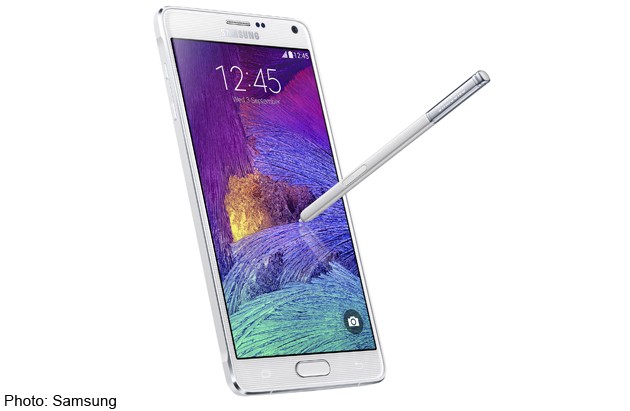Phone review: Samsung Galaxy Note 4

After years of touting a supersized phone, Samsung has finally established itself as the leader in the field with its Galaxy Note series of devices.
This is due in part to the number of followers who have attempted to jump on the phablet market that Samsung created, the most notable being Apple, which launched its 5.5-inch iPhone 6 Plus last month.
The followers have copied but rarely duplicated the large screen experience that has given Samsung a wide lead in features and functions.
A bigger phone is more than just tacking on a larger screen and a bigger battery. With the Note 4, Samsung is showing why it is still a leader in the category, even as its rivals try their best to catch up.
The introduction of a Quad High-Definition (QHD) screen here may not be the first for a smartphone, but having a super-sharp display does make sense on a 5.7-inch screen.
Text, icons and images are sharper to the eye and colours are more vibrant.
While Samsung has tweaked its Amoled displays to play up brighter colours, the overall tone is beautiful to the naked eye and more impressive than those of its competitors' products.
It has also added an adaptive display that tweaks the screen when it detects that a video, webpage or image is being shown. What makes this stand out is that it works wonderfully even outdoors.
Under the harsh sunlight, the screen dials up the saturation for an easier read, so there is no need to tweak the settings manually. Walk back into the shade and the colours return to normal.
Great photos, even in low light
Simple subtle changes have also been added to the S Pen stylus, to make it more user friendly and feature packed.
The new pen has twice the level of sensitivity as before, allowing users greater control while writing or drawing. This is great for users who love doodling on an electronic screen.
Add pen sensitivity to the new calligraphy handwriting mode and you get a more precise handwriting tool.
New pen controls allow users to cut and paste photos and text at the touch of a button. Taking a cue from the desktop, the smartphone cursor now acts like a mouse cursor and users can drag the cursor to select multiple files in a folder, or highlight passages of text on a webpage.
Multitasking is also more seamless than on the Note 3, as users can switch between windows and open split-screen windows with greater ease.
But the best feature of the Note 4 is the 16-megapixel camera that comes with optical image stabilisation.
Despite being an Android fan, I had long envied iOS users because the iPhone had the best smartphone camera.
Not any more.
The Note 4's camera offers greater details and colours than that of the iPhone 6 Plus and matches it in speed and low-light ability.
I took both the Note 4 and the Plus with me on a recent trip to New York and both performed admirably in daytime shots. Colours were vibrant and it was obvious that the phones used software enhancements on their images.
However, colours on the Note 4 were brighter, making the blue sky under a hot sun appear more vivid in a photograph, than in the same taken with the Plus.
Some may argue against extreme photos tweaks, but where Samsung wins is in the details. The Note 4 produced photos with sharper details, such as the texture of a brick wall, or light shadows on a high-rise building in the background.
This was even more apparent in low-light shots, with more authentic-looking images.
The image stabilisation here also resulted in great action shots and focused on the objects that mattered, from children running about, to flowing water.
It may seem unfair to compare the Note 4's 16MP camera with the 8MP camera on the Plus. Each is touted as being the best of its class.
But having built-in 4K video recording and a 3.7MP front camera for a wide-angled selfie shot give Samsung a far greater advantage.
Premium look but speaker tiny
In terms of design, Samsung has also revised some of its aesthetics and the Note 4 is the better for it.
The slightly curved plastic sides on previous Note phones have been replaced by a metallic, chamfered edge that gives the Note 4 a very elegant, premium look.
Unfortunately, the removable rear panel of the Note 4 is still undeniably plastic, although Samsung has opted for a flat rear panel, as opposed to the faux leather, perforated look of the Note 3.
The lone speaker is also disappointing, as one would expect massive sound from such a big device.
Its battery life has received a boost in the form of the ultra power saving mode, which was introduced in the Galaxy S5. The phone comes with a new adaptive charger that juices up the device faster than a regular charger.
While almost everything has been improved, Samsung has taken a retrograde step by using the older and slower USB 2.0 port instead of the USB 3.0 connector present in its most recent devices.

This article was first published on Oct 15, 2014.
Get a copy of Digital Life, The Straits Times or go to straitstimes.com for more stories.